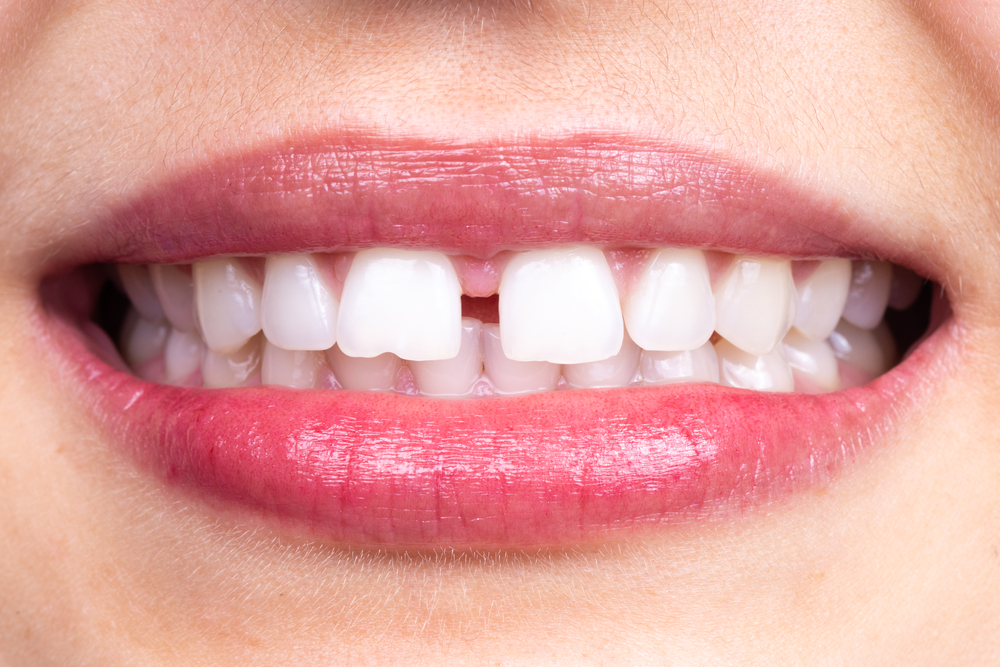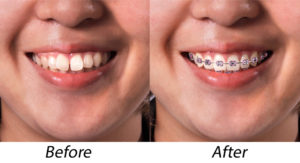
Our smile says a lot about us. It’s one of the first things people notice about us and a feature that people tend to remember long after you’ve met them. And if there’s something particularly unique or special about a person’s smile — like diastema between their two front teeth — we tend to remember it as a defining feature, also named as Diastema.
So What is Diastema?
It might not be obvious from just looking at the word itself, but diastema is typically easy to recognize once you see it. Simply put, diastema is a gap or space between your teeth, the most noticeable kind is often the gap between the two front teeth. Maybe a few celebrities come to mind who have a signature gap in their smile. That’s diastema, and it can show up in anyone — from children to adults. It refers to gaps in either the upper or lower jaws and is a fairly common orthodontic issue that affects around 25% of people. Diastema is a type of malocclusion or misalignment of teeth. Other types of malocclusion include crowding, overbites, underbites, and crossbites.
We should mention that when kids have gaps in their baby teeth, this is not considered diastema and shouldn’t cause parents to worry. Gaps between teeth at this stage are a good sign! Big gaps between baby teeth indicate that there should be room for the larger adult teeth when they come in. However, there are cases when gaps between teeth remain, even after all adult teeth have come in. This would be considered diastema.
Now that we’ve answered, “What is diastema?” you might be wondering whether or not having a gap in your teeth is an oral health concern. Yes and no. Diastema can indicate that you have an oral health issue like gum disease, but, no, just having diastema itself doesn’t automatically mean you have an oral health issue. In other words, the gaps in your teeth might just be aesthetic unless your Tulsa and Claremore orthodontist, Dr. Anand Patel, or your dentist finds otherwise.
Case in point, when patients come to The Brace Place with concerns about their diastema, it’s more often for aesthetic reasons. Some patients feel they would smile more confidently without a gap. Or sometimes spaced-out teeth can cause speech issues like lisping, especially if the gap is between the front teeth. In this latter case, orthodontic treatment paired with speech therapy can help eliminate speech difficulties.
What Causes a Gap Between Teeth?
Gaps between teeth happen for a variety of reasons. In his 20 years of experience, Dr. Patel has seen every cause for gaps in teeth and is highly experienced in treating them. Here, we’ll talk about the most common causes for gaps in teeth:
Genetics
Have you noticed that your siblings, parents, or grandparents have gaps between their teeth? Or maybe they used to but had their gaps fixed. Diastema is sometimes hereditary, passed down from parent to child. Your genes can contribute to orthodontic issues like:
The size and shape of your jaw
If your jaw is too large for your adult teeth, then there might be gaps between your teeth. On the other hand, the opposite orthodontic issue of diastema is crowding, where teeth are too tight together because the jaw is too narrow and shallow.
The size and shape of your teeth
Think back to when you were a kid. As we mentioned earlier, big gaps between baby teeth is a sign that there will be room for the larger adult teeth once they come in. But if the adult teeth that erupted are still quite small, this can result in diastema.
The proportions of your maxillary labial frenum
Feel your gums above your upper front teeth. There’s a connective tissue there called the maxillary labial frenum that joins the upper lip to your upper gums. If this tissue attachment is too wide or shallow, you might have frenulum tissue attachment which can create a tension that pulls the teeth away from each other, causing gaps between your front teeth.
Adult Teeth that Didn’t Erupt
It’s possible that once a baby tooth has fallen out, its adult replacement just doesn’t come in and there’s a gap in your smile. Sometimes this is hereditary and sometimes not. Research shows that about 20% of people are born with at least one adult tooth missing. In other cases, an adult tooth that fails to erupt might be because of external factors during development.
Prolonged Baby Habits
Another cause for diastema is infant habits like thumbsucking or tongue thrust that continued too far into early childhood. It goes without saying that these habits are a normal part of infancy: thumbsucking is a natural part of a baby’s self-soothing reflex, while tongue thrust shows that a baby knows how to prevent choking, pushing pureed foods away from the throat when it’s not wanted.
However, when these habits continue on into the toddler or early-elementary school years, they can affect a child’s orthodontic health, including creating a gap between the front teeth. So how does this happen?
Thumbsucking
This habit typically starts to lessen between ages 2-4, but if a child continues sucking their thumb into elementary school, the constant pressure against their front teeth and upper jaw can cause teeth to move outward and away from each other.
Tongue Thrust
Tongue thrust in older kids or adults can look like:
- the tip of the tongue sticking out between the teeth when you’re resting, sleeping, or swallowing.
- mouth breathing, even when you’re not congested
- you can’t completely close your lips
- slow, fast or messy eating
- lisping the “s” and “z” sounds when talking
Poor Oral Health
Another cause for gaps in teeth is poor oral health. Near the top of this article, we mentioned that diastema isn’t automatically a health concern. But it can be a sign of poor oral health. You see, gaps between teeth can create spaces for food debris to hide, resulting in inflamed or sore gums. If not addressed, this can lead to gum disease that loosens teeth, causing them to drift apart, flare, or even fall out, resulting in gaps.
Teeth Grinding or Jaw Clenching
Also known as bruxism, persistent teeth grinding and jaw clenching can cause diastema. Bruxism puts undue pressure on the upper teeth and makes them flare out, leaving a gap between them.
Complications from Diastema
Earlier on in this post, we talked about poor oral health as a possible cause of diastema. It’s also possible that diastema — combined with poor dental hygiene habits or other misalignment issues — can result in oral health issues like tooth decay and gum disease. It can be a bit of a vicious cycle: gaps in teeth can cause extra spaces for food debris to hide and gum disease to happen; gum disease can cause loose teeth that move apart and cause more space!
Another outcome of diastema is that the gaps between your teeth can result in bite issues. For example, if there’s a big gap in between your front teeth, this might not leave enough room for the teeth on either side. So those teeth end up crowding or becoming crooked.
Of course, we can’t forget to mention that diastema can also affect a person’s confidence. Some people feel embarrassed about their diastema and it prevents them from fully smiling. It’s safe to say that many of our patients who have gaps in their teeth come to us with concerns about how their teeth look and how that affects their self-confidence.
How to Treat Diastema: Braces and Invisalign
Now that we’ve covered what there is to know about diastema, you’re likely wondering how it’s treated. Can braces close gaps in teeth? How about Invisalign for gaps?
The answer to both is, yes! Both braces and Invisalign are effective for diastema closure. At The Brace Place, Dr. Patel and his team are experts in fixing gaps with braces and Invisalign. The one you end up using for your diastema will depend on your specific case. Considerations include- the severity of your gaps, whether you’re leaning towards braces or Invisalign, your budget, and lifestyle.
When you come to our Tulsa or Claremore office for your free initial consultation, a friendly team member will take complimentary x-rays and Dr. Patel will do a thorough exam to assess your diastema and overall orthodontic issues. We’ll then walk you through your diagnosis and suggested treatment.
If your diastema is because of a frenulum tissue attachment, you might need a frenectomy before starting braces or Invisalign treatment. For this simple and quick surgical procedure, a small portion of the maxillary labial frenum is removed so it stops pulling your teeth apart. It takes a few days for the frenulum to heal and then you’ll be ready for your braces or Invisalign.
Braces for Fixing Gaps in Teeth
Braces are typically the first recommended option for closing gaps between teeth and we’re experts with them. After all, we’re called The Brace Place!
We offer modern metal braces and ceramic braces that are discreet and streamlined. Trust us, these aren’t the bulky braces of generations past! These braces have smaller brackets and thinner wires that fix gaps between teeth discreetly, comfortably, and efficiently. Braces are a popular choice with our teen patients and those who like to express themselves with their choice of colorful elastics.
Traditional metal braces are still the most widely used for fixing gaps in teeth and other malocclusion issues. Another braces option is ceramic braces — also called clear braces. Ceramic braces have brackets made from a composite material that blends almost invisibly with your smile for a very discreet look. We offer our patients 3M Clarity™ ADVANCED ceramic brackets which withstand staining well, are durable, and low profile for comfort.
Treatment time with braces depends on the severity of your gaps. Some of our patients have had their gaps fixed with braces in as little as six months. But no matter how long it takes for braces to fix the gaps in your teeth, you’ll be happy to know that your braces “before-and-after” will be like night and day!
Invisalign Clear Aligners for Diastema Closure
At first, Invisalign was recommended by orthodontists only for milder malocclusion. But today, Invisalign, in the hands of an experienced orthodontist like Dr. Patel, can fix a wide variety of orthodontic concerns, including diastema.
Many of our adult patients in Tulsa and Claremore are interested in Invisalign for gaps in their teeth — they’re a great option for busy, on-the-go lifestyles. Invisalign is comfortable, easy, and you can barely see them. You wear your Invisalign clear aligners for at least 22 hours a day and you can eat and drink whatever you want. Take them out when eating, drinking anything other than water, and when brushing and flossing your teeth. Then simply pop them back in!
How long does it take for Invisalign to close a gap in teeth? Since every Invisalign treatment plan is customized to a patient’s orthodontic needs and smile goals, timing is different from person to person. A patient using Invisalign treatment for diastema can expect 18-30 sets of aligners that are switched out every 1-2 weeks.
Start Fixing Gaps in Your Teeth Today
We hope this post has helped you answer the questions, “What is diastema?” and “How do you treat it?” If you have more questions or are ready to start your journey towards a gap-free smile, please contact us for a free, in-person consultation at our Tulsa or Claremore, OK, office or book a virtual appointment today.



























